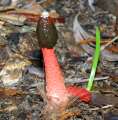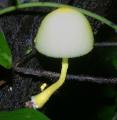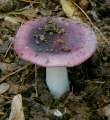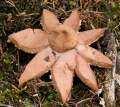Fungi of the World
Australia

|
Tropical Far North Queensland has perfect conditions for growing fungus - forests, warmth and plenty of water, so it's not surprising to find some real beauties, like this delicate example, which was totally destroyed by a rainstorm half an hour after I photographed it. |
|
This stinkhorn smells as bad as the name implies, but the stench is essential for attracting the flies it uses to spread its spores. This specimen looks much like ones I've seen in the United States, so I'm not sure if it's native - but then fungi have been around for hundreds of millions of years, which means they've had a good chance to spread around the planet. |

|

|
As well as varieties which grow on the ground there are fungi which grow on living and dead trees, like this one photographed on a night walk through the rainforest surrounding Cairns. |
Czech Republic
|
The mushrooms and toadstools of the Czech Republic include many weirdly shaped fungi and also many with colours very different from what most people imagine is possible. |

|
United States of America

|
These boletes are from the same location as the "chicken of the woods", Volo Bog nature reserve in northern Illinois. Swamps are just the sort of warm and damp environment where fungi thrive, such as these Phallic Fungi of the Great Swamp Wildlife Refuge in New Jersey. |
|
These orange balls are the reproductive phase of a slime mold, which despite the word "mold" in its name is really only an honorary fungus. In fact, it's not a fungus at all, nor is it an animal or a vegetable! Instead, slime molds constitute a "kingdom" of life all of their own. Some of them form giant single cell organisms with thousands of cell nuclei, others exist as single cell organisms which come together under certain conditions and form a single creature. Most of them move through or over rotting wood at about a millimeter an hour, consuming bacteria, and eventually move to the surface and produce fruiting bodies rather like fungi, complete with spores. They're just one of the species you might see during a fungi hunting foray at Devil's Lake in Wisconsin. |

|


